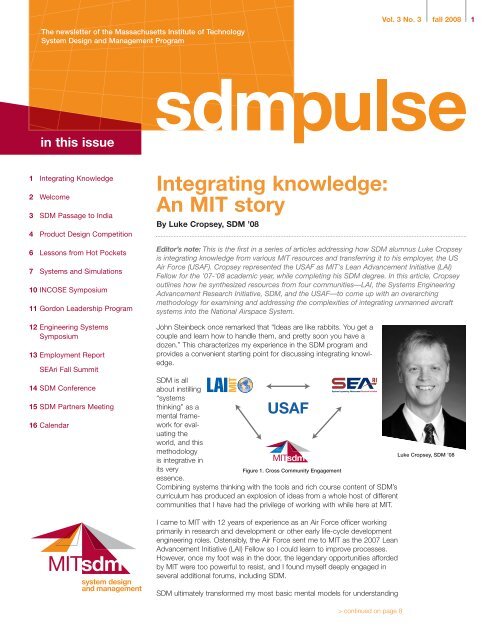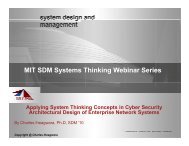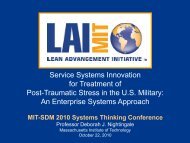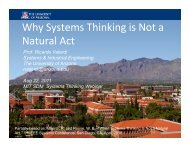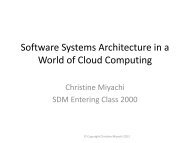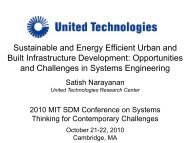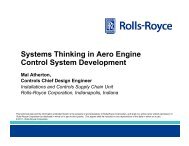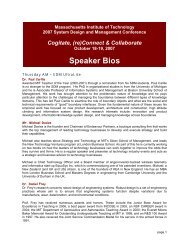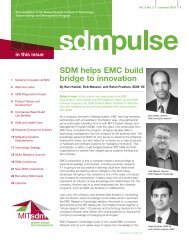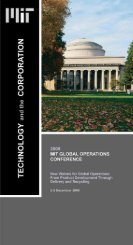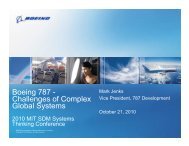SDMpulse_fall08 717 v5.qxd - MIT SDM
SDMpulse_fall08 717 v5.qxd - MIT SDM
SDMpulse_fall08 717 v5.qxd - MIT SDM
- No tags were found...
Create successful ePaper yourself
Turn your PDF publications into a flip-book with our unique Google optimized e-Paper software.
4 fall 2008 sdm.mit.eduTea anyone? New mug wins<strong>SDM</strong> design competitionBy Leigh Gautreau, <strong>SDM</strong> ’08Members of team JKLM posewith Peter Morley from the<strong>MIT</strong> machine shop, center,and their prize-winning teamug. Team members are, fromleft, Jeremy Katz, MichaelJohnston, Kenneth Liu, andLeigh Gautreau.Traveling down the stairwell of Building 9 to our basementclassroom, none of us in <strong>SDM</strong> had any clue howESD.40 Product Design and Development (PDD) wouldunfold. Some students had already thought about productsthey would like to develop, while others were directionlessbut hopeful.I found myself on a team with Jeremy Katz, KennethLiu, and Michael Johnston. Jeremy works on kerneldevelopment at Red Hat, Kenneth is a computer andelectrical engineer, Michael is a mechanical engineerwho works as a captain in the Coast Guard, and I am achemical engineer, but that is one of the most interestingaspects of <strong>SDM</strong> in general and ESD.40 in particular.Each unites people with a wide range of expertise onprojects outside their comfort zones. We created theteam name JKLM out of our initials, but none of usknew exactly what we wanted to develop. We just knewwe didn’t want it to involve software.One day after class, while talking with teaching assistantAlyson Scherer about markets with underserved needs,the subject of tea drinkers on the go emerged. Thisgroup seemed to have good market potential sincethere appeared to be no adequate solution to the problemof what to do with used tea bags. Moreover,because tea is growing in popularity, we think convenienceis an important key to expansion. Our goal was torevolutionize the tea market so that on-the-go tea is ascommon as coffee in the United States.I believe our prospects are good. Already a process thatbegan at the start of term as a simple practice of identi-fying user needs has solidified into a viable product—theT2Go mug—which won first place and $1,000 worth ofAmerican Express gift checks in the 2008 PDD designcompetition, the capstone to the ESD.40 class.ESD.40 is both a class and a competition; groups formand compete to identify a concept, develop a design,build a prototype, and evaluate the business case for aproduct that surpasses those of other groups. Thecourse structure helped JKLM focus on a need and singleout a user group, both of which led to JKLM’s realizationof a timely idea. ESD.40 provides students with aframework within which to develop products. Lecturesabout identifying and interviewing user groups, forexample, were followed by presentations on how teamsemployed the techniques taught. Likewise, lectures onthe House of Quality (which ranks engineering characteristicsin terms of how they address user needs) andPugh Selection Process (used to select the productattributes that best address user needs) were also followedby presentations demonstrating the implementationof these techniques by the various groups.Our team found the experiential learning aspect ofESD.40 most valuable; it transcended the classroom.The four of us listened to users, observed them carefully,and engaged them in the product developmentprocess. Narrowing down the user group and needswas a challenge. Often users jumped directly toanswers, while we struggled to get them to focus onproblem statements. But once the problem was clearlydefined, the solution began to define itself almostnaturally.JKLM’s product was designed to fill the needs of teadrinkers who want to grab their cup and go—board atrain, catch their carpool, or walk to work—without havingto worry about bitter tea or tea bag disposal.JKLM faced strict budgetary ($800) and time constraints(a 14-week semester), which were overcome by utilizingsome of the techniques described in ESD.40 to boundthe proposed solution. Results of user interviews andsurveys were narrowed down with the House of Qualitymethodology. Once viable engineering characteristicswere identified, these were used to generate concepts,which were then compared to a datum (an existing travel
51. Infuser in closed position 2. Unscrew to reveal holes 3. Infuser in open position4. Remove black screw lid, fill with tea 5. Insert infuser assembly in hot water, steepas desired, then close6. Convenient storage at bottomtea mug) using the Pugh Matrix. Then the best conceptor amalgamation of concepts was selected. JKLM conductedthorough patent and commercial productsearches and refined the design to improve upon andsurpass existing products. We also developed a businesscase for the product looking at costs in the development,manufacturing, and distribution domains.Staff in the <strong>MIT</strong> machine shop helped us understandwhat was feasible, given the time and money allotted.The shop’s supervisor, Peter Morley, in particular contributedto our success by making our prototype in hisfree time.The tea mug JKLM designed features an integratedinfuser in its lid that opens for steeping and closes toend steeping with a turn of a knob. This feature keepsthe tea from getting bitter without forcing the user toremove a dripping tea bag. JKLM’s design also incorporatesan insulated cup to keep the tea the right temperatureand storage at the bottom for sweeteners or extratea. The mug canbe used for eithertea bags or looseleaf tea, and it isdishwasher safe.Our prototype mugfaced off againstsome terrific productsin the PDDdesign competition—includingan7. Easy to clean, dishwasher safeautomated mail delivery system,a solar-powered refrigerator, an umbrella dryer,and a touch-up paint dispenser—so our team wasextremely proud to win first place. This success hasinspired us to continue our work. Since the semester’sconclusion, JKLM has identified several companies thatmay be interested in producing the T2Go travel mug.Only time will tell how far this traveling tea mug will go.
6fall 2008sdm.mit.eduHot Pockets cofounder sharessuccess story with <strong>SDM</strong>By Emad D. Zand, <strong>SDM</strong> ’08Editor’s note: In spring 2008, Emad D. Zand, <strong>SDM</strong> ’08, organized a lecture titled “The Story of Hot Pockets and anEntrepreneur’s Life,” delivered by David Merage, cofounder of Chef America, which was launched in 1977. Zand,who is copresident of the <strong>MIT</strong> Sloan Middle East Business Club, offers his impressions of the talk.David Merage, cofounder ofChef America (known for itsHot Pockets) poses with EmadD. Zand, <strong>SDM</strong> ’08, and othersduring his visit to <strong>MIT</strong> lastspring. From left: PatrickZeitouni, MBA ’09, copresidentof <strong>MIT</strong> Sloan Middle EastBusiness Club; John M. Grace,<strong>SDM</strong> industry codirector;Shimrit Ben-Yair, MBA ’09,copresident of <strong>MIT</strong> SloanMarketing Club; Zand; Merage;Pat Hale, director of the <strong>SDM</strong>Fellows Program; PeterKurzina, <strong>MIT</strong> Sloan senior lecturer;David Weber, director of<strong>MIT</strong> Sloan corporate relations;and Faisal Alibrahim, MBA ’09,copresident of <strong>MIT</strong> SloanMiddle East Business Club.Many <strong>SDM</strong> students, myself included, have entrepreneurialaspirations when they arrive at <strong>MIT</strong>. The plan is toleverage rich technical experience, combined with newskill sets in systems thinking and business developedduring the program, and take the business world bystorm. Hearing real-life stories from prominent entrepreneurshelps all of us to understand the many factors thatcontribute to success—not just leadership skills but alsovision, determination, the ability to choose good partners,and the willingness to make sacrifices and to take risksalong the way.In spring 2008, David Merage, cofounder of ChefAmerica, delivered a lecture at <strong>MIT</strong> titled “The Story ofHot Pockets and an Entrepreneur’s Life.” Chef Americais a national frozen food manufacturer known for creatingand marketing many innovative and successful products,including Hot Pockets, Lean Pockets, and CroissantPockets. In 2002, Chef America was sold to Nestlé. Atthe time of its sale, it had reached $750 million in annualsales, employed 1,800 people, and was growing at a rateof 15 percent per year, making it one of the fastest growingfood companies in the world. Nestlé acquired ChefAmerica for $2.6 billion.Secret of successIn his talk, Merage said that the entrepreneurial spirit runsstrong in his family; his father encouraged him to build afamily business as a strategy to foster personal and familystrength. But it was also clear that Merage had drive,competency, and the resourcefulness needed by a successfulentrepreneur.During a business trip to Europe, Merage and his brotherdiscovered Belgian waffles, which had yet to be introducedto the American market. Inspired, they went towork, researching business models and testing conceptviability before concluding that manufacturingand distributing a frozen waffleproduct to coffee shops and restaurantswould yield the highest return.With a lot of drive but without any previoustechnical expertise or any experiencein the food industry, the teamspent nights and weekends engineeringequipment, formulating recipes, and creatingproducts in a garage-like setting.In 1977, Merage, his brother, and theirfather formed Chef America and beganmass production of their Belgian waffles.Building on that success, they soonbegan research and development on afrozen lunch product that they called the“Hot Pocket” and sold to schools, caterers, and vendingcompanies.Merage stressed that employees’ dedication to the corporation’sgoals was crucial to the venture’s success. Thefounders were able to create a sense of community andrespect for employees and not allow room for politics inthe organization. The transparency of the organizationboosted employees’ sense of belonging and kept themmotivated. Transparency and respect are much moreeffective than financial incentives in motivating employeesto meet corporate objectives, Merage said.More than 80 students and faculty members attendedthe talk, which was open to all <strong>MIT</strong> students. Sponsoredby the System Design and Management Program, <strong>MIT</strong>Entrepreneurship Center, <strong>MIT</strong> Sloan Jewish StudentsOrganization, <strong>MIT</strong> Sloan Marketing Club, and <strong>MIT</strong> SloanMiddle East Business Club, the lecture was followed by aluncheon at the <strong>MIT</strong> Faculty Club for a small group of students,who had the opportunity to dine with Merage andask more specific questions in a less formal setting.
9Value IdentificationValue PropositionEnterprise PurposeCrawleyGoal Check:CompleteConsistentAttainableText for first columnAlternative ArchitecturesRhodes &NightingaleText for center columnText for last columntext for the boxtext for the boxtext for the boxtext for the boxtext for the boxStakeholder AnalysisText for the toptext for the boxChart oneChart twoCDABChart threeChart sixGrossi/RossText for the toptext for the boxChart fiveChart fourValue AlignmentNightingale& StankeFigure 4. Value Identification Stage.Crawley & DoriArchitecture TradeoffssideinformationsideinformationinformationcenterinformationsidesideinformationinformationinformationFigure 5. Value Proposition Stage.ATAMThe approach is centered around the enterprise architectingmodels proposed by Nightingale and Rhodes (LAIand SEAri repsectively) and implemented through a rigorousObject Process Methodology (OPM) adapted fromDov Dori by Crawley (<strong>SDM</strong>).Value DeliveryText for the topOnce the alternative enterprise architectures are createdusing these two tools, a preferred architecture is selectedusing an approach developed by the SoftwareEngineering Institute called the Architecture TradeoffAnalysis Method (ATAM), which I discovered through discussionwith an LAI researcher.The final step in value-creation is the value delivery stage.The primary methods used in this portion of the analysisleverage the ATAM method results highlighting key architecturalleverage points with the LAI EnterpriseTransformation Roadmap. The result is a concrete,actionable plan for moving the enterprise forward in deliveringthe specified value.Where does the impact of integrating these methodologiesshow up? Fundamentally, the result of combiningthese constructs is a rigorous, methodical approach toachieving value flow in complex stakeholder enterprisesoperating in a context that is dynamic and highly fluid.Using a well-established value foundation grounds themethod. Implementing both the system and enterprisearchitecting approaches allows the strengths of eachperspective to inform the other. The system architectingperspective is significantly expanded through use ofthe enterprise architecting lens, but the enterpriseLargertitle textLargertitle textsmall textsmall textsmall textsmall textsmall textsmall textsmall textsmall textsmall textsmall textTransformationRoadmapLargertitle textVery small text at the top of a box• text in the box• text in the box• text in the box• text in the box• text in the boxVery small text at the top of a box• text in the box• text in the box• text in the box• text in the box• text in the boxText at the bottom• text in the box• text in the box• text in the box• text in the box when the line needs to be long• text in the box when the line needs to be long• text in the box when the line needs to be longFigure 6. Value Delivery Stage.VerysmalltextVerysmalltextVerysmalltextarchitecting practice is significantly bolstered by the applicationof rigorous OPM approaches from system architecting.The resulting methodology is a robust approach to tyingvalue directly to an enterprise architecture that provides asmall textsmall textLargertitle textLargertitle textLargertitle textsmall textsmall textLargertitle textsmall textsmall textsmall text• text in the box• text in the box• text in the box• text in the boxText at the topVery small text at the top of a box• text in the box longer line• text in the box longer line• text in the box longer lineVery small text at the top of a box• text in the box longer line• text in the box longer line• text in the box longer lineVery small text at the top of a box• text in the box longer line• text in the box longer line• text in the box longer line> continued on page 12
10 fall 2008 sdm.mit.edu<strong>SDM</strong>, ESD make mark at INCOSEsymposiumBy Lois Slavin, <strong>MIT</strong> <strong>SDM</strong> communications director<strong>SDM</strong> and <strong>MIT</strong>’s Engineering Systems Division (ESD)played a prominent role in the annual international symposiumsponsored by the International Council onSystems Engineering (INCOSE) that was held June 15-20, 2008, in Utrecht, Netherlands. The conference themewas “Systems Engineering for the Planet.”Scholars from ESD’s Systems Engineering AdvancementResearch Initiative (SEAri) won the two INCOSE bestpaper awards at the conference:• ESD research scientist Adam Ross and ESD seniorlecturer in engineering systems and principalresearch scientist Donna Rhodes were honored for“Using Natural Value-centric Time Scales forConceptualizing Systems Timelines through Epoch-Era Analysis.”• ESD PhD candidate Matthew Richards, ESDProfessor Daniel Hastings, Ross, and Rhodes wonfor “Two Empirical Tests of Design Principles forSurvivable System Architecture.”Read more about SEAri on Page 13.In addition, <strong>SDM</strong> and ESD PhD alumnus Rudolf Smalingand Associate Professor Olivier de Weck were honoredwith the best journal paper award for 2007 by SystemsEngineering for “Assessing Risks and Opportunities ofTechnology Infusion in System Design.”Sharing best practicesSeveral representatives from ESD and <strong>SDM</strong> played majorroles in the conference. Pat Hale, director of the <strong>SDM</strong>Fellows Program and president of INCOSE, noted thatparticipation in INCOSE is extremely beneficial for <strong>SDM</strong>and ESD. “Many of us are active in running workshopsand making presentations, which helps forge strongalliances to help evolve and advance the fields of engineeringsystems and systems engineering,” he said.“<strong>SDM</strong> is also making use of many of the conferencematerials in its systems engineering classes, to infusethem with the most forward-thinking best practices.”current engineering systems research, while also enablingthem to share interests and broaden their networks. Morethan 60 people attended.ESD faculty and students also made several presentations,including:• “Collaborative Systems Thinking Research: ExploringSystems Thinking within Teams” by <strong>MIT</strong> studentCaroline Lamb and Rhodes• “Measuring Systems Engineering Success: Insightsfrom Baseball,” by <strong>MIT</strong> student Craig Blackburnalong with <strong>MIT</strong> research associate and INCOSEtreasurer Ricardo Valerdi• “Safety-Driven SE Methodology” by Nicolas Dulac<strong>MIT</strong> PhD ’07, Professor Nancy Leveson, and others• “Strategic SE—Changeability and Commonality” byde WeckValerdi also participated in team presentations on“COSYSMO Reuse Extension and Proposed Modificationto COSYSMO Estimating Relationship” (COSYSMOstands for Constructive Systems Engineering CostModel).Throughout the symposium, ESD and <strong>SDM</strong> staged anexhibit at which ESD students showcased their researchand ESD and <strong>SDM</strong> literature was distributed.“Topics covered in this year’s conference were broad,ranging across many different domains and approachingthe same scope in which ESD is interested,” Rhodessaid. “Next year’s event will be held in Singapore, andESD and <strong>SDM</strong> are definitely planning to be there again.”ESD’s participation included conducting a day-long workshopon engineering systems for members of the Councilof Engineering Systems Universities, conducted by ESDProfessor Daniel Roos and Rhodes. According toRhodes, who is a past president of INCOSE, the eventwas designed to give attendees a larger perspective on
11Gordon Program extends leadershiptraining to <strong>MIT</strong> undergradsBy Kathryn O’Neill, managing editor, <strong>SDM</strong> PulseWith the launch of the Bernard M. Gordon-<strong>MIT</strong> EngineeringLeadership Program this fall, <strong>MIT</strong> has expanded its commitmentto the same kind of engineering leadership trainingthat is the hallmark of the System Design andManagement Program.Founded with a $20 million gift from the Gordon Foundation,the new program is designed to ensure that undergraduatesin the School of Engineering are prepared tobecome engineering leaders. Professor Edward F.Crawley of aeronautics and astronautics and engineeringsystems, a founding codirector of <strong>SDM</strong>, is the program’sdirector.“It’s not that there is a lack of opportunities for leadershipat <strong>MIT</strong>,” said Joel Schindall, interim industry codirector ofthe Gordon Program. “It’s that there’s no roadmap andno integrated approach.”<strong>MIT</strong> alumnus Bernard M. Gordon, SB ’48, SM ’49, has avision to change that. The holder of more than 200patents and the founder of Analogic Corporation andNeuroLogica Corporation, Gordon has been instrumentalin seeding a number of engineering leadership programsaround the country through the Gordon Foundation.<strong>MIT</strong>’s is the first to target undergraduates.“In view of increasing global competition, we need to reinforceproduct engineering education—the education ofthose who innovate and put products into production—for which the United States has a great demand,” Gordonsaid in announcing his gift to <strong>MIT</strong> last July. “<strong>MIT</strong> and itsstudents, as potential leaders, have an obligation to thenation to do this.”The Gordon Program will provide structured leadershiptraining in conjunction with hands-on project work—aneffort to return a roll-up-your-sleeves-and-get-it-donementality to engineering education, which has becomemore theoretical and research-oriented over the last severaldecades, according to Schindall, who is also theBernard M. Gordon professor of the practice of productengineering.The program has four main components, the first ofwhich is to enhance the curriculum of every engineeringstudent with hands-on leadership training and practice.The second is to provide additional knowledge and experiencefor students with an interest in engineering leadership.In addition to advanced courses, the program willprovide resources and mentoring to students who pursueextracurricular leadership opportunities at <strong>MIT</strong>—fromdesign competitions to the Undergraduate PracticeOpportunities Program to entrepreneurship. “One of theexciting things about the Gordon Program is that wedon’t have to invent new activities. We’re going to usewhat’s already here,” Schindall said.A third component of the program provides for about 30students each year to become Gordon EngineeringLeaders, a special track that requires a two-year commitment(similar to the commitment required for a minor)plus ongoing involvement as alumni. Fifteen studentswere admitted into this year’s pilot class of Leaders. Asthe program gains ground, deliberate efforts will be madeto disseminate best practices. This fourth component isparticularly important to Gordon, because <strong>MIT</strong> is a rolemodel for engineering education.Schindall stressed that “There are some great synergiesbetween the Gordon Program and the work that <strong>MIT</strong>’sEngineering Systems Division is already doing through<strong>SDM</strong> and other programs. We have already discussedsome exciting opportunities for collaboration, and we arelooking forward to working together.”<strong>SDM</strong> adopting similar modelUndergraduates aren’t the only students at <strong>MIT</strong> with the hunger formore leadership training. As part of its five-year curriculum reviewprocess, <strong>SDM</strong> conducted a survey of current students, programalumni, as well as partner companies and found one commonrefrain was the need for <strong>SDM</strong> to expand its leadership program toinclude the practical application of skills.In response, <strong>SDM</strong> is constructing a new framework that includes arestructured leadership curriculum. The Independent ActivitiesPeriod will be used to provide students with leadership tools andsome firsthand experience. Leadership events will be incorporatedinto each business trip, an experiential class will be added thatinvolves an actual corporate project, and a fall capstone class willrequire additional leadership coursework and a final compilation ofpapers.“These changes will ensure that <strong>SDM</strong> graduates are better preparedto lead technical companies across a wide range of industries,”said Pat Hale, director of the <strong>SDM</strong> Fellows Program.Like the Gordon Program, <strong>SDM</strong> plans to make use of some of<strong>MIT</strong>’s existing leadership resources. For example, students maygain hands-on experience through the Global EntrepreneurshipLab, <strong>MIT</strong> Sloan’s Laboratory for Sustainable Business, theEntrepreneurship Lab, and student committees. Recognizing theimportance of internships, <strong>SDM</strong> is also working to make it easier forstudents to take time during the summer to work.Changes to <strong>SDM</strong>’s curriculum will go into effect for the 2009cohort. Current students will have the option to continue with theprogram at entry or adopt the new approach.—Kathryn O’Neill
12 fall 2008 sdm.mit.eduEngineering Systems Symposiumslated for June 2009By Kathryn O’Neill, managing editor, <strong>SDM</strong> Pulse<strong>MIT</strong> will host the second Engineering SystemsSymposium on campus June 15-17, 2009, in WongAuditorium. The event is open to the public.Although the symposium is still in the planning stages,two keynote speakers have been confirmed: Charles M.Vest, president of the National Academy of Engineeringand former president of <strong>MIT</strong>, and Norman Augustine,retired chairman and CEO of Lockheed MartinCorporation. The symposium is being cochaired byESD’s founding director, Daniel Roos, professor of engineeringsystems and civil and environmental engineering,and Christopher Magee, professor of the practice ofmechanical engineering and engineering systems.The tentative symposium schedule calls for two days ofplenary sessions and one day of breakout sessions onspecific research areas. The plenary sessions will include:1) Joint presentations from university and industry representativesdemonstrating how research advanceshave been practically applied to significant engineeringsystems problems.2) A discussion on how engineering systems canaddress the current and future needs of industry.3) A discussion of the field’s intellectual agenda—including engineering systems concepts and frameworks—andapplication to challenges in specificdomains such as energy and health care.4) A broad look at the future of engineering and the roleof engineering systems in engineering research andeducation.“This is very much an evolving field,” Roos said, notingthat engineering systems programs are organized differentlyat different universities. Timed to coincide with the10th anniversary of the <strong>MIT</strong> Engineering Systems Division(ESD), the symposium offers an opportunity to explorethe best ways to move the field forward, he said.The first Engineering Systems Symposium, held at <strong>MIT</strong> in2004, was very much a “call to arms,” Roos said. “Theresounding conclusion of the first symposium was thatthis [field] is terribly important to pursue.” The event,which was at capacity with more than 300 people attending,led to the founding of the Council of EngineeringSystems Universities (CESUN).CESUN is now a thriving organization with more than 30members—and a sponsor of the 2009 symposium. Todate, the International Council on Systems Engineeringand the Institute of Industrial Engineers have also signedon as sponsors and many of their members are expectedto attend. “With so many other universities now involvedin engineering systems, I couldn’t be happier,” Roos said.Integrating knowledge: An <strong>MIT</strong> story> continued from page 9seamless transition to detailed product design later in thedevelopment cycle. This approach is especially useful insituations that involve a large number of stakeholdersand/or government agencies and regulators where arrivingat a common definition of value can be extremelychallenging.In the next article, tools used in the methodology justdescribed will be examined in more detail. Practicalexamples will yield insights that a trip down theory lanewill not provide. The third and final article in this serieswill provide a glimpse of the potential impact and valuedelivery the analysis may have on the UAS airspaceintegration challenge. This last article will include asummary discussion concerning the extensibility of theapproach to other venues and will round out themethodology development.
13<strong>SDM</strong> grads offer employerscompetitive edgeBy Helen M. Trimble, director, <strong>SDM</strong> Career DevelopmentHelen M. TrimbleFellows from <strong>MIT</strong>’s System Design and ManagementProgram are experienced professionals representing a widerange of industries. This, coupled with their academicpreparation in leadership, systems thinking, and managingcomplex systems, makes them ideal employees who canwork across organizational boundaries to solve enterprisewidechallenges.Unlike other academic programs, <strong>SDM</strong> has a flexiblerecruitment cycle. Companies can interview and hire selffundedcandidates year-round by requesting resumes orvisiting the <strong>MIT</strong> campus. A major recruitment event thisyear will be held November 11–14, and it will provide anopportunity for company representatives to interview many<strong>SDM</strong> fellows.The best news is that there are no preconditions for companiesto participate in <strong>SDM</strong> recruitment activities, and it isvery economical. Career development professionals estimatethat a search at key technical leadership levels suchas manager or director easily costs $40,000—or 20 percentto 30 percent of the annual salary. Even with today’sincreased transportation costs, airfare from your city pluslodging and food expenses for one to two days inCambridge (approximately $325/day at a first-rate hotel),campus recruiting still provides impressive savings.William Taylor III, <strong>SDM</strong> ’01, now COO of ClemsonUniversity’s Computational Center for Mobility Systems,recruited <strong>SDM</strong> graduates for Eaton Corporation when heworked for that company. “Recruitment week is a chancefor industry to get engaged with <strong>SDM</strong> students, find outwhat their interests and abilities are, and hopefully find agood match for some leadership positions,” said Taylor. “Ithelps to interact with them both inside and outside theinterview room. Recruitment week offers chances to dothat.”From the student perspective, Trinidad Grange-Kyner, <strong>SDM</strong>’07, now a senior consultant at Deloitte Touche, stated, “Iparticipated in <strong>SDM</strong> recruitment week because of the targetedmanner in which all activities were designed andconducted. It was a gathering of targeted companies thatalready knew what they were looking for in <strong>SDM</strong> studentsso there was no need to ‘sell’ them on the value of theprogram.”For information on <strong>SDM</strong> recruitment activities and attendingrecruitment week—November 11–14, 2008—contactHelen Trimble at htrimble@mit.edu or 617.258.8256SEAri plans fall research summitThe <strong>MIT</strong> Systems Engineering Advancement ResearchInitiative (SEAri) will hold its annual research summit onOctober 21, 2008, at the <strong>MIT</strong> Faculty Club. The summit isdesigned to showcase the group’s ongoing research intothe theories, methods, and effective practice of systemsengineering. The event will bring research sponsors andinvited experts together with SEAri researchers, students,and affiliated faculty to evaluate the relevance and potentialimpact of ongoing projects in SEAri’s research portfolio.The current research portfolio includes projects related tosocio-technical decision making, designing for valuerobustness, systems engineering economics, and systemsengineering in the enterprise. SEAri research outcomesare synthesized and formulated to providestrategic guidance in the form of books, process documents,and policy recommendations.Interim research results were shared at various conferencesin 2008. SEAri work received the Institute ofElectrical and Electronics Engineers’ Systems ConferenceBest Paper award, both of the best paper awards at theInternational Council on Systems Engineering’s annualsymposium (see story, page 10), and the ResponsiveSpace Conference’s Best Student Paper award.The SEAri research group interacts with its sponsors on aregular basis as research projects progress, but the summitprovides added value to all attendees, encouraging aricher dialogue and cross-project insights. Last year’sattendees found the summit to be informative, and alsonoted the value of having a research-oriented dialoguewith peers from other sponsoring organizations. SEAriDirector Donna Rhodes remarked that the event is thehighlight of the group’s fall semester, “providing us withinsight into how we can make adjustments to ourresearch program in order to have real impact in the systemscommunity we serve.”For more information, visit the SEAri website atseari.mit.edu or contact the leadership team atseari@mit.edu.
14 fall 2008 sdm.mit.edu<strong>SDM</strong> 2008 conference explores systemsthinking for contemporary challengesBy Lois Slavin, <strong>MIT</strong> <strong>SDM</strong> communications directorSystems thinkers from around the globe will convene at<strong>MIT</strong> on October 23–24, 2008, to hear <strong>MIT</strong> experts andindustry leaders discuss how to apply a systemsapproach to large-scale, complex projects. The theme ofthis year’s conference, which is sponsored annually by<strong>SDM</strong>, is “Systems Thinking for ContemporaryChallenges.” Topics to be covered include sustainabilityand the environment, product design, entrepreneurship,and software.According to conference chair Vineet Thuvara, <strong>SDM</strong> ’06,the conference has been carefully crafted to offer practicalinformation that can be applied across industries.“The intent is for attendees to be able to provide demonstrablebusiness and technical value to their companieswhen they return to the office,” said Thuvara, a seniormanager at Microsoft.Insights from academia, industrySpeakers from <strong>MIT</strong> will include Peter Senge, foundingchair of the Society for Organizational Learning, <strong>MIT</strong>Sloan senior lecturer, and author of The Fifth Discipline:The Art and Practice of the Learning Organization; YossiSheffi, professor of engineering systems and civil andenvironmental engineering, director of the <strong>MIT</strong>Engineering Systems Division (ESD), director of the <strong>MIT</strong>Center for Transportation and Logistics, and director andApplying systems thinkingfounder of the Master of Engineering in LogisticsProgram; Olivier de Weck, associate professor of aeronauticsand astronautics and engineering systems andassociate director of ESD; Pat Hale, director, <strong>MIT</strong> <strong>SDM</strong>Fellows Program, senior lecturer <strong>MIT</strong> ESD, and presidentof the International Council on Systems Engineering;Nancy Leveson, professor of aeronautics and astronauticsand engineering systems; and Annalisa L. Weigel, theJerome C. Hunsacker assistant professor of aeronauticsand astronautics and engineering systems.Industry speakers include Valerie Casey, co-head of softwareexperience practice, IDEO; John deVadoss, seniordirector for technical strategy, Microsoft Corporation; PaulMurray, director of sustainability, Herman Miller; GirishKumar Navani, cofounder and CEO, eClinicalWorks;Michael Schulte, head of consulting services, Capgemini;Lee Ng, director of new business creation, AgilentTechnologies; and Dharmesh Shah, founder and chiefsoftware architect, HubSpot.We invite you to join us on October 23–24, 2008! To register,contact John M. Grace, <strong>SDM</strong> industry codirector,jmgrace@mit.edu, 617.253.2081.Look for coverage of the symposium in the next issue ofthe <strong>SDM</strong> Pulse.> continued from page 7every TOPSIM is a systems model of the businessprocess and entity that is customizable.The solutionFirst we benchmarked TOPSIM against other vendors inthe market. <strong>SDM</strong> Professor Edward F. Crawley’s frameworkfor critiquing and re-architecting system architecturewas really useful in arriving at the basic set of changes,viewed from a user perspective. We also ran a survey tocapture both software delights and pains, in addition tooverall user experience. We used quality function deploymentto capture our first-cut analysis.We then crafted new system performance goals and,through a variety of design tools (a design structurematrix was actively used), we arrived at a new design. Wealso evolved new process maps for the modeling, design,and development of the new architecture. Care wastaken to allow for the various “ilities” as they are key tothe revenue stream of software applications.The new architecture also required us to approach development,especially of the model for complex numericmodel, in a different way. This change is an ongoing one,but we have already defined new templates for the modelingwhich allow us to develop a prototype in MicrosoftExcel and import it into the new architecture. We are nowinvestigating a change to a visual way of modeling, customizedto our needs, in which modelers can show theflow and design of a complete business process througha graphical interface. The model could then be importedinto an object-oriented source code library.The new product architecture is now being tested withone of our clients in Florida.As we discussed the project in the <strong>MIT</strong> <strong>SDM</strong> certificatereviews, we also realized that the visual modeling methodwhen combined with an Applications Service Providerdelivery model could be used to generate a totally differentrevenue stream—from Internet-based users who canaccess the solution from different locations, which allowsfor scalability as well as authorship by independent consultants.<strong>MIT</strong> faculty and reviewers gave invaluable inputon how this could be commercialized, and my group isnow preparing the first set of specifications on how totake this to the Internet-based model.
15Rich agenda planned for <strong>SDM</strong>partners meetingBy John M. Grace, <strong>SDM</strong> industry codirectorThe annual meeting of <strong>SDM</strong> industry partners will takeplace on October 22, 2008, at the <strong>MIT</strong> Faculty Club from8:30 am to 4 pm.<strong>SDM</strong> industry partners are firms that actively support studentsin <strong>SDM</strong> programs. Such support can range from fullto partial funding for an <strong>SDM</strong> master’s student, full supportfor an <strong>SDM</strong> certificate student, or support of thesisresearch. In all of these situations, close interactionbetween the industry partner, <strong>SDM</strong> student, <strong>MIT</strong> faculty,and the <strong>SDM</strong> program is encouraged.This year’s meeting provides an opportunity for partnersto exchange ideas with their peers, <strong>SDM</strong> directors, and<strong>MIT</strong> faculty as well as to share information about theireducational and research needs. <strong>MIT</strong>’s open environment,coupled with a meeting format structured to promoteactive discussion among companies, faculty, and programstaff, provides opportunities that cannot easily beduplicated.The agenda for the October 2008 meeting includes:• An update on <strong>SDM</strong> curriculum modifications andoptions resulting from a yearlong review• Faculty presentations on “Systems Engineering forChangeability” and “Commonality and SoftwareSystems Engineering,” with ample time for questions.• A look at the <strong>SDM</strong> certificate program—growth,potential, and opportunities—and the options itoffers partner companies to build or strengthensystems thinking internally.• Leadership development within <strong>SDM</strong>’s curriculumand its relation to industry partner needs. Summariesof various partner companies’ leadership programswill be presented and discussed.• Summary of scope and content of award-winning<strong>SDM</strong> theses for 2008 will be presented. Discussionand comments from firms will be encouraged.• An open forum discussion on engineering systemsissues in service industries. This area is of great interestto both <strong>MIT</strong>’s Engineering Systems Division and to<strong>SDM</strong>, which are actively seeking industry input.The annual partners’ meeting has historically been viewedby <strong>SDM</strong> industry partners and the program as an excellentway to obtain feedback on direction, needs, and currentissues facing both the program and its critical customerbase in companies.For further information, please contact John M. Grace,<strong>SDM</strong> industry codirector, jmgrace@mit.edu,617.253.2081.Hands-on lessons in India> continued from page 3this might not be possible because of the local attitudeabout women. While the initial project—implementing aweb-based loan application program—seems infeasible,our team did come up with a solid alternative. However,even this alternative did have local impediments to overcome.Overall, I certainly learned a great deal about the “totalsystem” approach. I better understand what the villagersneed and what possible solutions could be implementedto serve those needs. In a way, my experienceswith the actual customers and their environment in Indiahelped me further appreciate what I had learned allsemester in <strong>SDM</strong>’s Product Design and Developmentclass. Thanks to <strong>SDM</strong>, I was also able to interview thevillagers more effectively, focusing their attention on theirproblems rather than prying them for possible solutions.Through surveys and focus group discussions, I developeda needs assessment that can be used to evaluatefuture concepts.This school in Rajugela was founded by the India School Fund. Leigh Gautreau, <strong>SDM</strong>’08, worked with representatives from the fund on her India project.
16 fall 2008 sdm.mit.edu<strong>SDM</strong> calendarfall 2008–summer 2009If you or your colleagues are interested in attending any of the events listed, please contact<strong>SDM</strong> Industry Codirector John M. Grace at jmgrace@mit.edu or 617.253.2081.October 21, 2008<strong>SDM</strong> Information EveningLocation: <strong>MIT</strong> Faculty ClubTime: 6:30–9:30 pmOctober 21, 2008SEAri Research SummitLocation: <strong>MIT</strong> Faculty ClubTime: 8:30 am–5 pmDetails: See page 13October 22, 2008<strong>SDM</strong> Partners MeetingLocation: <strong>MIT</strong> Faculty ClubTime: 8:30 am–4 pmDetails: See page 15October 23–24, 2008<strong>SDM</strong> ConferenceSystems Thinking for ContemporaryChallengesLocation: Broad Auditorium; Bartos TheaterOpen to: General publicDetails: sdm.mit.edu/conf08October 30–31, 2008CMI Cambridge-<strong>MIT</strong> Workshop onEngineering ChangeLocation: <strong>MIT</strong> Endicott HouseJanuary 5–30, 2009<strong>SDM</strong> January SessionLocation: <strong>MIT</strong>June 15–17, 2009Engineering Systems SymposiumLocation: Wong AuditoriumSpeakers:• Charles M. Vest, president of the National Academyof Engineering and former president of <strong>MIT</strong>• Norman Augustine, retired chairman and CEO ofLockheed Martin CorporationDetails: See page 12July 20–23, 2009<strong>MIT</strong> Engineering Systems Division and <strong>SDM</strong>at INCOSE 2009 SymposiumLocation: SingaporeEvent information includes all details available at press time. For more current event information, go to sdm.mit.edu and esd.mit.edu.


